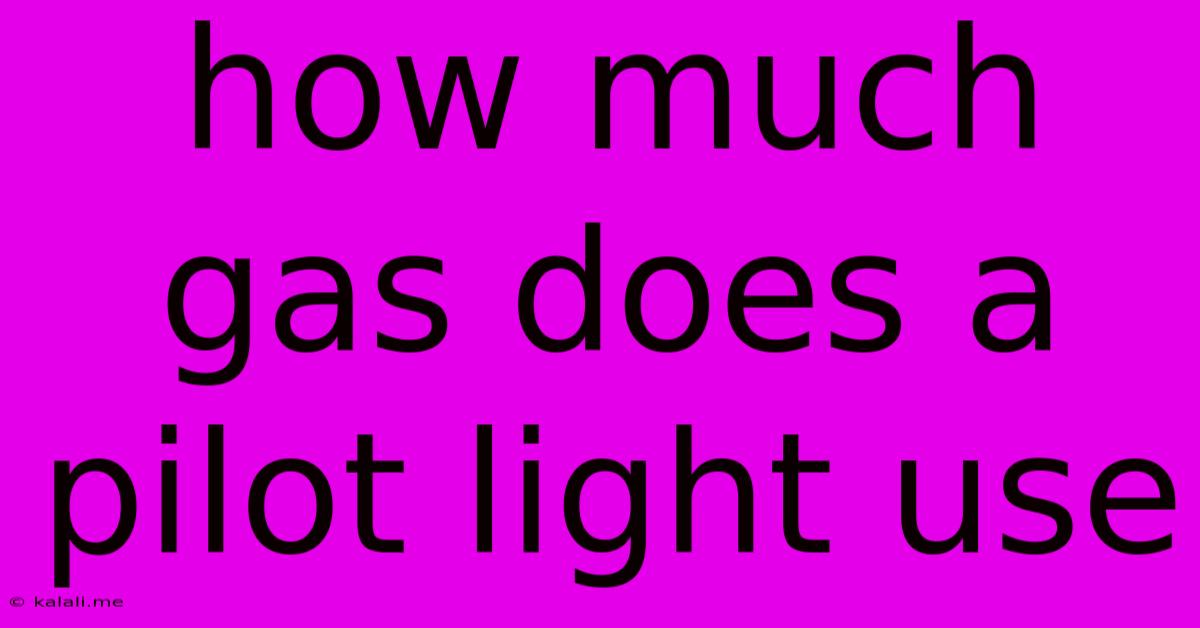How Much Gas Does A Pilot Light Use
Kalali
Jun 04, 2025 · 2 min read

Table of Contents
How Much Gas Does a Pilot Light Use? A Surprisingly Significant Energy Drain
Are you aware of that tiny, perpetually burning flame in your gas appliances? It's the pilot light, a seemingly insignificant component that quietly sips gas 24/7. While it's convenient, its constant energy consumption might surprise you. This article delves into how much gas a pilot light actually uses, the factors influencing its gas consumption, and how you can potentially reduce this often-overlooked energy drain.
Understanding Pilot Light Gas Consumption:
The amount of natural gas a pilot light uses is relatively small, but it adds up over time. A typical pilot light consumes anywhere from 0.003 to 0.01 cubic feet of natural gas per hour (cfh). This might seem negligible, but consider this:
- Continuous Operation: Pilot lights operate continuously, even when the appliance isn't in use. This constant burning translates to a significant amount of gas used annually.
- Multiple Appliances: Many homes have multiple gas appliances – water heaters, furnaces, ovens – each with its own pilot light. The cumulative gas consumption from all these pilot lights becomes much more substantial.
- Cost Accumulation: While the cost per hour might be insignificant, the yearly cost from all your pilot lights can range from a few dollars to several tens of dollars, depending on your gas rates and the number of appliances.
Factors Affecting Pilot Light Gas Consumption:
Several factors can influence the amount of gas a pilot light consumes:
- Pilot Light Size and Design: Larger pilot lights naturally burn more gas than smaller ones. The design of the pilot assembly itself also plays a role in efficiency.
- Gas Pressure: Fluctuations in gas pressure can impact gas consumption. Higher pressure can lead to increased gas usage.
- Age of the Appliance: Older appliances may have less efficient pilot lights, resulting in higher gas consumption.
Reducing Pilot Light Gas Consumption:
While eliminating pilot lights altogether might not be feasible with all appliances, several strategies can help mitigate their energy consumption:
- Electronic Ignition Systems: Modern appliances often feature electronic ignition systems, eliminating the need for a constantly burning pilot light. These systems ignite the burner only when needed, drastically reducing gas consumption. Consider upgrading older appliances with electronic ignition when feasible.
- Regular Maintenance: Ensure your appliances are properly maintained. A poorly adjusted pilot light can consume more gas than necessary. Regular servicing by a qualified technician can help optimize performance and efficiency.
- Proper Ventilation: Good ventilation around gas appliances ensures efficient combustion and prevents wasted gas.
The Bottom Line:
While the individual gas consumption of a single pilot light might appear minimal, the cumulative impact on your energy bill and environmental footprint is noteworthy, especially over a year's time. By understanding the factors affecting pilot light gas usage and exploring options like electronic ignition systems, you can reduce this often-overlooked energy drain and contribute to a more energy-efficient home. Remember, small changes can accumulate to make a big difference.
Latest Posts
Latest Posts
-
When You Re Available Next Or Next Availble
Jun 06, 2025
-
How To Disable Ds4 In Steam
Jun 06, 2025
-
Toilet Not Flushing And Filling Up With Water
Jun 06, 2025
-
How Big Of A Tank Does A Goldfish Need
Jun 06, 2025
-
What Does Jss Mean In Walking Dead
Jun 06, 2025
Related Post
Thank you for visiting our website which covers about How Much Gas Does A Pilot Light Use . We hope the information provided has been useful to you. Feel free to contact us if you have any questions or need further assistance. See you next time and don't miss to bookmark.